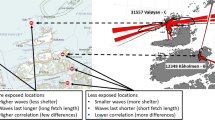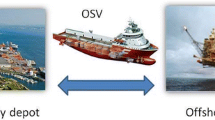Abstract
Standard ocean shipping contracts stipulate that a chartered vessel must sail at ‘utmost despatch’, with no consideration for the availability of berths at the destination port. The berthing policies used at many ports, which admit vessels on a first-come, first-served basis, provide an additional incentive for the master to sail at full speed. These legacy contracts and berthing policies constitute a major driver of harbour congestion and marine fuel consumption, with adverse economic, safety, and environmental consequences. We propose a methodology to evaluate the potential benefits of new berthing policies and ocean shipping contracts. Given the importance of stochasticity on the performance of maritime transport systems, and the need to represent the efficient allocation of terminal resources, we have chosen a hybrid simulation-optimization approach. Our discrete event simulation model represents vessels and their principal economic and physical characteristics, the spatial layout of the terminal, performance of the land-side equipment, contractual agreements and associated penalties, and berthing policies. The proposed optimization model – a substantial extension of the traditional berth assignment problem – represents the logic of the terminal planner. The simulation program solves multiple instances of the optimization model successively in order to represent the progression of planning activities at the terminal.



Similar content being viewed by others
References
Alderton, P. (2005) Reeds Sea Transport Operations and Economics, 5th edn. London: Thomas Reed Publications.
Asperen, E. van,, Dekker, R., Polman, M.T.H. and Swaan Arons, H. de (2003) Modeling ship arrivals in ports. In: S. Chick, P.J. Sànchez, D. Ferrin and D.J. Morrice (eds.), Proceedings of the 2003 Winter Simulation Conference. 7–10 December, New Orleans, LA, pp. 1737–1744.
Bertsimas, D. and Weismantel, R. (2005) Optimization over Integers. Charlestown, MA: Dynamic Ideas.
Bunkerworld. (2010), http://www.bunkerworld.com/prices/, accessed 15 January 2010.
Clarksons. (2010) Dry Bulk Trade Outlook, January 2010. London: Clarkson Research Services Limited.
Corbett, A. (2009) Safety push to cut traffic at Newcastle. Tradewinds, 16 October.
Cordeau, J., Laporte, G., Legato, P. and Moccia, L. (2005) Models and tabu search heuristics for the berth allocation problem. Transportation Science 39 (4): 526–538.
Daganzo, C.F. (1990) The productivity of multipurpose seaport terminals. Transportation Science 24 (3): 205–216.
Dahal, K., Galloway, S., Burt, G. and McDonald, J. (2003) Port system simulation facility with an optimization capability. International Journal of Computational Intelligence and Applications 3 (4): 395–410.
Dalsøren, S., Eide, M., Endresen, Ø., Mjelde, A., Gravir, G. and Isaksen, I. (2009) Update on emissions and environmental impacts from the international fleet of ships. The contribution from major ship types and ports. Atmospheric Chemistry and Physics 9: 2171–2194.
Dragovic, B., Park, N. and Radmilovi, C.Z. (2006) Ship-berth link performance evaluation: Simulation and analytical approaches. Maritime Policy & Management 33 (3): 281–299.
Dragovic, B., Park, N., Radmilovi, C.Z. and Maras, V. (2005) Simulation modelling of ship berth link with priority service. Maritime Economics & Logistics 7: 316–335.
Fourer, R., Gay, D. and Kernighan, B. (2003) AMPL, A Modeling Language for Mathematical Programming, 2nd edn. Toronto: Thomson.
Golias, M.M., Saharidis, G.K., Boile, M., Theofanis, S. and Ierapetritou, M.G. (2009) The berth allocation problem: Optimizing vessel arrival time. Maritime Economics & Logistics 11 (4): 358–377.
Gurobi Optimization. (2009) Gurobi Optimizer Reference Manual, 2nd edn, http://www.gurobi.com/html/doc/refman/, accessed 22 December 2009.
Hartmann, S. (2004) Generating scenarios from simulation and optimization of container terminal logistics. OR Spectrum 26 (2): 171–192.
Imai, A., Nishimura, E. and Papadimitriou, S. (2001) The dynamic berth allocation problem for a container port. Transportation Research Part B 35 (4): 401–417.
Imai, A., Nishimura, E. and Papadimitriou, S. (2008) Berthing ships at a multi-user container terminal with a limited quay capacity. Transportation Research Part E 44: 136–151.
INTERTANKO and OCIMF. (2010) Virtual Arrival – A Best Practice Guide. London: INTERTANKO and OCIMF.
Lee, D.-H., Wang, H.Q. and Miao, L. (2008) Quay crane scheduling with non-interference constraints in port container terminals. Transportation Research Part E 44: 124–135.
Lloyds Register Fairplay. (2009) World fleet database (all civilian ocean-going ships above 299 gt), http://www.lrfairplay.com/, accessed 30 October 2009.
Mjelde, A., Fjell, C., Eriksen, S.M. and Frevaag, J. (2009) Tiltaksanalyse -krav om landstrøm for skip i norske havner. (in Norwegian). Det Norske Veritas, Oslo. Technical Report 1063.
Moccia, L. (2004) New optimization models and algorithms for the management of maritime container terminals. PhD thesis, Universita degli studi della Calabria.
Monaco, M. and Sammarra, M. (2007) The berth allocation problem: A strong formulation solved by a lagrangean approach. Transportation Science 41 (2): 265–280.
Røsæg, E. (2009) A system for queuing in ports. In: A. Pozdnakova (ed.) Scandinavian Institute of Maritime Law Yearbook 2008. Norway: Sjørettsfondet.
Sabria, F. and Daganzo, C. (1989) Approximate expressions for queuing systems with scheduled arrivals and established service order. Transportation Science 23: 159–165.
Stahlbock, R. and Voβ, S. (2007) Operations research at container terminals – A literature update. OR Spectrum 30 (1): 1–52.
Steenken, D., Voβ, S. and Stahlbock, R. (2004) Container terminal operation and operations research – A classification and literature review. OR Spectrum 26: 3–49.
Strandenes, S. and Wolfstetter, E. (2005) Efficient (re-)scheduling: An auction approach. Economics Letters 89: 187–192.
Vis, I. and de Koster, R. (2003) Transhipment of containers at a container terminal: An overview. European Journal of Operations Research 147: 1–16.
Acknowledgements
We gratefully acknowledge financial support from the Norwegian Research Council, Project 192930. We thank Magnus Eide and Trond Nilssen of Det Norske Veritas for initial conversations on the simulation model, as well as their help in assembling the data used in the case study.
Author information
Authors and Affiliations
Corresponding author
Rights and permissions
About this article
Cite this article
Alvarez, J., Longva, T. & Engebrethsen, E. A methodology to assess vessel berthing and speed optimization policies. Marit Econ Logist 12, 327–346 (2010). https://doi.org/10.1057/mel.2010.11
Published:
Issue Date:
DOI: https://doi.org/10.1057/mel.2010.11




